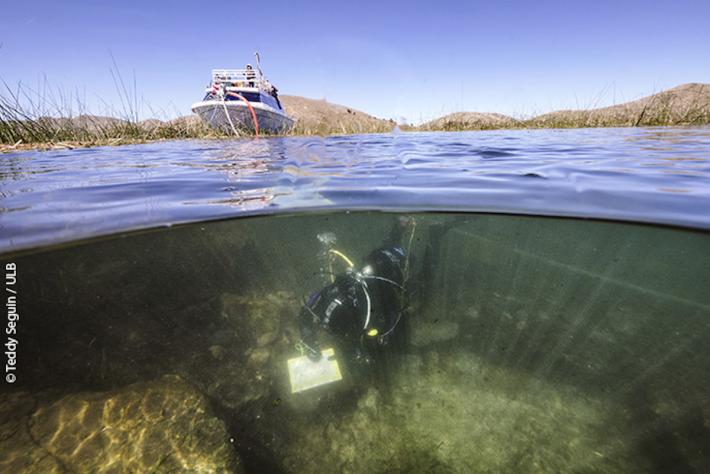
Divers work to recover and study remains from the Antikythera shipwreck in 2012.
Archaeology is a field that is constantly producing new and exciting finds, yet most people may not realize that many actually come from beneath the surface of the world’s many oceans, seas, rivers, and lakes.
Since time immemorial, humans have lived near and traversed across bodies of water which have played a critical role in the development of trade, agriculture, and technological advancement the world over. Many sites have been lost over time due to changing coastlines or natural disasters, while other finds like shipwrecks have simply been the product of historical happenstance. Excavation of many of these sites requires a level of specialization beyond the expectation of land-bound archaeologists. There are also some spots that are shallow enough that tourists can go and see for themselves the extraordinary circumstances of underwater archaeological sites.
Here is a list of some of the most significant underwater finds in recent decades, some of which are still accessible to the public.

Accessible to the Public: No
Located in the Aegean Sea off the coast of the Greek island, Antikythera, this Roman-period shipwreck (100-75 BCE) was discovered by sponge divers in 1900. The wreck contained a large number of artifacts, such as a collection of exquisite statues in both marble and bronze. The most significant was the mysterious so-called Antikythera Mechanism. The statues alone were significant finds, as extent bronze statues are rare finds from antiquity since they are very often at risk of being melted down for other purposes throughout history. The Antikythera mechanism puzzled archaeologists for years but it is now commonly accepted that it was some sort of calendrical device (possibly the world’s oldest analog computer), used to predict astronomical positions and eclipses.

Accessible to the Public: No
One of the highest lakes in the world at 3,810 meters above sea level, Lake Titicaca has provided archaeologists with ample finds over the years, continuing to embellish our understanding of pre-Colombian cultures. The lake has revealed shrines replete with offerings, ancient homes, and the earliest-known pre-Colombian port in the Incan world. There is also evidence that young llamas were decorated and adorned with prestige items to be sacrificed to the waters of the lake. Carbon dating has put many of the sacrifice victims somewhere between the eighth and tenth centuries CE. The work being done here recently is unique and historic due to the high level of collaboration between the archaeologists and the indigenous communities of the area.

Accessible to the Public: Yes, but waters are not always optimal.
The Egyptian port city of Thonis-Heracleion enjoyed almost a thousand years of inhabitation before seismic activity and rising sea levels literally turned the ground it was built into the sand, sending centuries of history into the Mediterranean. Rediscovered in 1999 and explored sporadically since then, finds from the site indicate that the city was the most prosperous between the sixth and fourth centuries BCE. Statues of Greco-Egyptian gods, pottery, coins, and entire temples have come forth from the sea, illuminating the character of this important port to Alexandria further along the Nile River. The most recent find was just this summer when the European Institute of Underwater Archaeology located a new shipwreck dating to the Ptolemaic era, possibly the second century BCE.

Accessible to the Public: Yes, but a guide is needed.
While most of this archaeological site is still on dry land, the lower town of Baiae has been completely submerged in the Mediterranean thanks to the Campania region’s notorious volcanic activity. Baiae was something of a resort town during the Roman period, with multiple imperial villas and stories about the infamous behavior of its residents recorded by Roman authors. When the volcanic fields nearby caused a portion of the town to lower, it preserved beneath the sea countless stunning mosaics that once adorned the floors of Claudius’ nymphaeum and Baiae’s bath complexes. Tourists can swim out into the bay to see the roads, statues, and mosaics in place under the water, however, you will first need to book a tour with a verified guide.

Accessible to the Public: Special permissions and a guide are needed.
Although it was one of the largest European cities in the Western Hemisphere by the late 1600s, nature decimated Port Royal on June 7th, 1692 when an estimated 7.5 magnitude earthquake struck Jamaica. A total of thirty-three acres of the city were cast into the sea and over 2,000 people were killed. The remains of the city now rest forty feet below the surface and have provided some of the best evidence we have for colonial Caribbean life in the seventeenth century. Many of the buildings slipped into the sea intact which included whatever was inside of them. While special permissions from the Jamaican government are needed to dive into this National Heritage site, much of what has been recovered can be seen in the Museum of History and Ethnography at the Institute of Jamaica in Kingston.

Accessible to the Public: Yes.
Designated as a Marine Sanctuary, Thunder Bay is a 4,300 square-mile underwater museum in Lake Huron that houses some of America’s best-preserved and historically significant shipwrecks. Through the unique circumstances of these ships’ preservation, scholars and visiting divers alike can learn an unparalleled amount about America’s shipping and commercial industries of the last two hundred years. The boats ranged in style and type from wooden schooners to early model steel-hulled steamers and tell the tale of the Great Lakes maritime history through a unique and profound setting. The wrecks range in location and especially depth with some visible above the waves while others lie upwards of two hundred feet beneath the surface.

Accessible to the Public: Unclear.
Just off the coast of Atlit, Israel lies the submerged ruins of the Neolithic site of Atlit-Yam. The village measures about ten acres in size and has produced some of the best and oldest evidence thus far for Neolithic lives on the Levantine coast. Researchers have located rectangular houses, a well, many burials, and a stone circle of seven megaliths weighing around 1,300 pounds each. Today, the village rests between 25 and 40 feet beneath the surface of the Mediterranean Sea, but at the time of its habitation around 8,900-8,300 years ago Atlit-Yam was a coastal settlement that made ample use of the sea’s resources. It has been theorized that the village met its end when Mount Etna, in faraway Sicily, experienced a volcanic collapse that subsequently caused a tsunami, that destroyed many coastal towns across the Eastern Mediterranean at the same time.

Accessible to the Public: No.
The Uluburun Shipwreck represents one of the most important maritime archaeological finds ever made. Dating to the late fourteenth century BCE, the shipwreck has provided scholars with crucial information about Late Bronze Age trading networks and political contact across the Mediterranean Sea. The wreck was located in 1982 off the shore of Uluburun, Turkey by local sponge divers (the method of discovery for many shipwrecks). From 1984 to 1994, researchers dove down 144 to 170 feet to study the ship and recover what remained within its hold. The ship measured between 49 and 52 feet long and was constructed from Lebanese cedar and oak wood. The contents of its cargo were stunningly rich with glass, copper, and tin ingots, jars of glass beads, olives, and resin, and other fine goods of glass, quartz, gold, silver, pottery, and ivory. It has been concluded that the ship originated somewhere near Cyprus or the modern Syrio-Palestine coast and was possibly headed for a port somewhere further into the Aegean to redistribute its goods, many of which were of Egyptian origin.

Accessible to the Public: Yes
The city of Pavlopetri dates to about five thousand years ago, which makes it one of the oldest submerged cities in the Mediterranean Sea. The full extent of the site’s lifespan ranges from the Bronze Age through to the late Mycenaean period, giving researchers a diachronic view of life there until the town was struck by three earthquakes sometime around 1000 BCE. Pavlopetri is unique even amongst underwater sites for the city still boasts nearly a full town plan with streets, structures, and even tombs extent under the water. Most of the city is between 9 and 13 feet deep which makes studying these remains less complicated than other sites, however, it also means that the city is at greater risk of damage and erosion due to boats, tourists, and looters. It is listed as a UNESCO Underwater Cultural Heritage site and visitors should treat the site with respect when visiting.

Accessible to the Public: Yes, but diving experience is recommended due to the nature of the waters here.
Also known as Antirhodos, this island was once situated in the eastern harbor of Alexandria, Egypt until it sunk beneath the waves sometime in the 4th century CE after earthquakes and tsunamis crumbled the earth beneath. All of the island’s structures now rest about 16 feet underwater, including the Ptolemaic palace which it is now best known for. Roads, jetties, temples, columns, and sphinxes all now cover the seabed along with the palatial ruins. Researchers removed many materials from the Alexandrian harbor while studying these remains including some of the finer discoveries of pottery, jewelry, hairpins, glass cups, and other prestige items. Based on the dates of the finds, it has been concluded that between Cleopatra’s death and the island’s sinking, much of the palace was abandoned thus making the archaeology here particularly interesting to scholars of Ptolemaic Egypt before the Romans took over.
Danielle Vander Horst
Dani is a freelance artist, writer, and a trained archaeologist. Her research specialty focuses on religion in the Roman Northwest, but her educational background encompasses more broadly Greek and Roman art, architecture, materiality, and history. She holds multiple degrees in Classics and Archaeology from the University of Rochester, Cornell University, and Duke University, and she is currently completing a PhD in History of Art & Archaeology at Cornell University.























